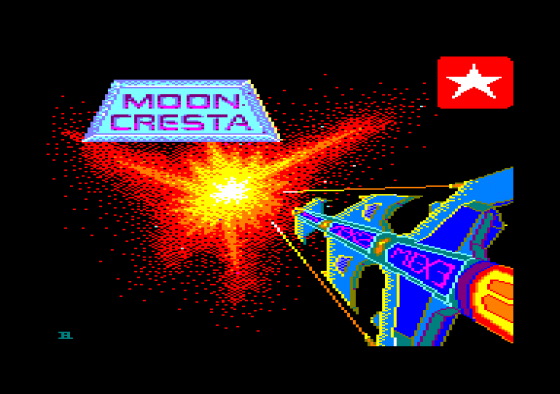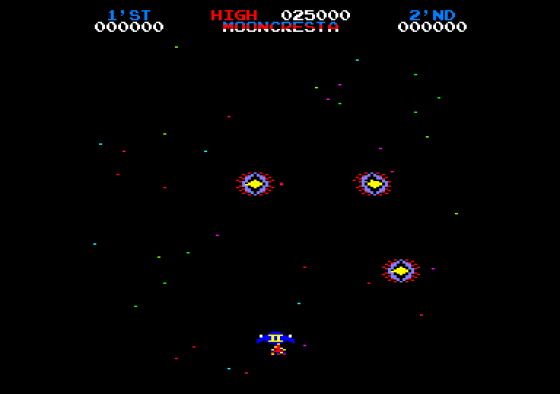
Amstrad Computer User
 1st May 1986
1st May 1986
Categories: Review: Software
Publisher: Incentive
Machine: Amstrad CPC464
Published in Amstrad Computer User #18
Moon Cresta
In the bad old days before home computers had more than 4k RAM good computer games could only be found in arcades, cafes and the local kebab take-away.
In those early days there were only a few rules - left, right or shoot. The complex controls of Defender had not been contemplated. Even the addition of thrust, the fourth button on an Asteroids machine, was seen as adventurous - and no-one used the hyperspace.
Those were the days - every game cost 10p and all the machines were set on the easy levels. Now you can pay 50p for one game of Space Harrier.

One of the first major advances was colour. No longer did the aliens only go green when they reached the bottom row, they went blue, red, scarlet, pink, white - whatever colour you wanted anywhere on the screen.
One of the first of these colour games was Moon Cresta. This represented a big advance in computer games. When you heat the first kind of alien there was another, totally different type ready to get you. The Amstrad version of Moon Cresta is amazingly faithful to the original, thanks in no small part to Incentive having a Moon Cresta machine of their own - for research, of course.
As you go through the levels the game changes. The early aliens swoop slowly but unpredictably. Later foes are more predictable but very much faster - you need to be quick on the trigger to catch them before they run into you.
About half way through the cycle of sheets there is a docking sequence where you must line up your ship with a larger ship. If you should get killed you are reincarnated in the form of the later ship. Once you have docked you have the fire power of both ships at your disposal, and people thought Galaga was original when you could have two ships on the screen at a time. The ultimate in status is to get all three ships docked, giving you the ability to have five bullets in the air (space?) at once.
In the cafe where I used to play we had a table top machine - the kind where players sat either side. The players who wanted to show off would tweak the joystick with their knees and dock without using their hands.
Here the Incentive conversion seems to lack something because the ships move in much larger steps and you don't need to be nearly as accurate to elicit the message: "Right on!" from your 'straddy.
Moon Cresta used a screen on its side. To avoid your having to turn the Amstrad monitor through 90 degrees Incentive have done some very clever things with the 6845 video controller. This gives the screen more rows of fewer columns, just the right appearance for the game. There is some clever interrupt handling going on to print the scores in Mode 1 while the rest of the game is in Mode 0.
All in all this is a very competent conversion. However Moon Cresta is a very old game - programs to the standard of Batman or Tau Ceti would have astounded the programmers who wrote Moon Cresta.
This is a game from the long forgotten age of left, right, fire.
If you enjoyed Moon Cresta in those days you will still enjoy it now, but as a new release it shows its age. Maybe it will be very successful - after all, Zalaga was a hit on the BBC Micro and that is just a simple blast-'em - but I would only buy the game for sentimental reasons.
There is something strangely addictive about Moon Cresta, and there is a competition to win a real arcade machine if you can score more than 30,000 points.
Other Reviews Of Moon Cresta For The Amstrad CPC464
Moon Cresta (Incentive)
A review by Bob Wade (Amstrad Action)
Moon Cresta (Incentive)
A review



